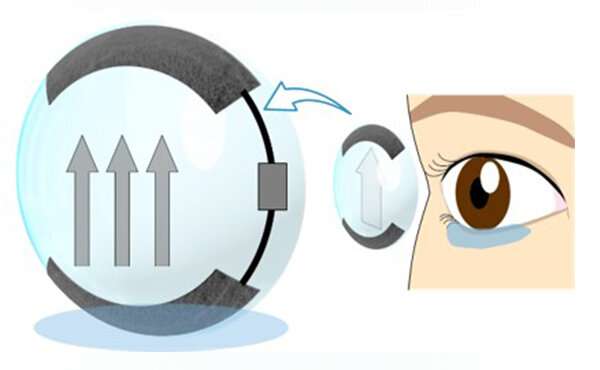Self-moisturizing smart contact lenses

Researchers at Tohoku University have developed a new type of smart contact lenses that can prevent dry eyes. The self-moisturizing system, which is described in the journal Advanced Materials Technologies, maintains a layer of fluid between the contact lens and the eye using a novel mechanism.
Smart contact lenses are wearable devices that could accelerate vision beyond natural human capabilities. They are being developed for a wide range of applications from non-invasive monitoring to vision correction to augmented reality display.
"Although there have been many recent advancements in new functions for smart contact lenses, there has been little progress in solving the drawbacks associated with wearing contact lenses day to day," says Professor Matsuhiko Nishizawa, an engineer at Tohoku University.
One of the biggest problems with contact lenses is they can cause "dry eye syndrome" due to reduced blinking and increased moisture evaporation. Dry eye syndrome can lead to corneal wounds and inflammation as well as a feeling of discomfort.
In order to tackle this important problem, the researchers developed a new mechanism that keeps the lens moist. The system uses electroosmotic flow (EOF), which causes liquid to flow when a voltage is applied across a charged surface. In this case, a current applied to a hydrogel causes fluid to flow upwards from the patient's temporary tear reservoir behind the lower eyelid to the surface of the eye.
"This is the first demonstration that EOF in a soft contact lens can keep the lens moist," says Nishizawa.
The researchers also explored the possibility of using a wireless power supply for the contact lenses. They tested two types of battery, a magnesium-oxygen battery and an enzymatic fructose-oxygen fuel cell, both of which are known to be safe and non-toxic for living cells. They showed that the system can be successfully powered by these biobatteries, which can be mounted directly on the charged contact lens.
Further research is needed to develop improved self-moisturizing contact lenses that are tougher and capable of operating at smaller currents.
"In the future, there is scope to expand this technology for other applications, such as drug delivery," says Nishizawa.
More information: Shinya Kusama et al. Self‐Moisturizing Smart Contact Lens Employing Electroosmosis, Advanced Materials Technologies (2019). DOI: 10.1002/admt.201900889
Provided by Tohoku University




















